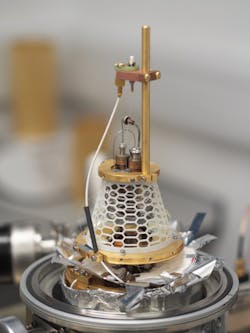Miniature space-qualified platform cools superconducting single-photon IR detector
A miniaturized Stirling and Joule-Thomson (J-T) cooling platform, which was the prototype design for the cooler launched in 2009 onboard an Ariane 5 rocket as part of the Planck space mission, has been applied to cool superconducting nanowire single-photon detectors (SNSPDs) to 4.2 K by a team of researchers from the University of Glasgow (Glasgow, Scotland), STFC Rutherford Appleton Laboratory (Didcot, England), Single Quantum (Delft, Netherlands), and the Royal Institute of Technology (KTH; Stockholm, Sweden). The SNSPD class of infrared (IR) single-photon detectors offers superior detection efficiency, low timing jitter, much lower dark-count rate, and longer-wavelength (to 5 μm) sensitivity compared to competing indium gallium arsenide/indium phosphide (InGaAs/InP)-based single-photon avalanche photodiodes (SPADs) that are limited to 1.7 μm operation. However, SNSPD deployment outside the laboratory has been hindered, until now, by the need for expensive, bulky, power-hungry cryogenic cooling systems or hazardous liquid helium.
The miniaturized cryostat system consists of the prototype spaceborne cooler with a 170 K first-stage Stirling, 20 K second-stage Stirling, and 4.2 K third-stage J-T cooler, where a SNSPD mount was placed to hold the fiber-coupled single-pixel detector, which has a 20% detection efficiency at 1310 nm. The gas compressors were developed for spaceborne applications using flexure bearings for long life. This configuration requires only 130 W of input power and could easily be optimized to fit in a 19 in. rack and run from a battery. The current detector was used to demonstrate single-photon light detection and ranging (lidar) applications at 1310 nm, as well as singlet oxygen luminescence detection at 1270 nm that could enable dose monitoring for photodynamic therapy in cancer treatment. Reference: N. R. Gemmell et al., Supercond. Sci. Technol., 30, 11, 1-6 (Sep. 29, 2017).
About the Author

Gail Overton
Senior Editor (2004-2020)
Gail has more than 30 years of engineering, marketing, product management, and editorial experience in the photonics and optical communications industry. Before joining the staff at Laser Focus World in 2004, she held many product management and product marketing roles in the fiber-optics industry, most notably at Hughes (El Segundo, CA), GTE Labs (Waltham, MA), Corning (Corning, NY), Photon Kinetics (Beaverton, OR), and Newport Corporation (Irvine, CA). During her marketing career, Gail published articles in WDM Solutions and Sensors magazine and traveled internationally to conduct product and sales training. Gail received her BS degree in physics, with an emphasis in optics, from San Diego State University in San Diego, CA in May 1986.
